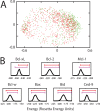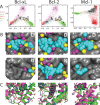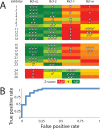Selectivity by small-molecule inhibitors of protein interactions can be driven by protein surface fluctuations
- PMID: 25706586
- PMCID: PMC4338137
- DOI: 10.1371/journal.pcbi.1004081
Selectivity by small-molecule inhibitors of protein interactions can be driven by protein surface fluctuations
Abstract
Small-molecules that inhibit interactions between specific pairs of proteins have long represented a promising avenue for therapeutic intervention in a variety of settings. Structural studies have shown that in many cases, the inhibitor-bound protein adopts a conformation that is distinct from its unbound and its protein-bound conformations. This plasticity of the protein surface presents a major challenge in predicting which members of a protein family will be inhibited by a given ligand. Here, we use biased simulations of Bcl-2-family proteins to generate ensembles of low-energy conformations that contain surface pockets suitable for small molecule binding. We find that the resulting conformational ensembles include surface pockets that mimic those observed in inhibitor-bound crystal structures. Next, we find that the ensembles generated using different members of this protein family are overlapping but distinct, and that the activity of a given compound against a particular family member (ligand selectivity) can be predicted from whether the corresponding ensemble samples a complementary surface pocket. Finally, we find that each ensemble includes certain surface pockets that are not shared by any other family member: while no inhibitors have yet been identified to take advantage of these pockets, we expect that chemical scaffolds complementing these "distinct" pockets will prove highly selective for their targets. The opportunity to achieve target selectivity within a protein family by exploiting differences in surface fluctuations represents a new paradigm that may facilitate design of family-selective small-molecule inhibitors of protein-protein interactions.
Conflict of interest statement
The authors have declared that no competing interests exist.
Figures








Similar articles
-
Druggable protein interaction sites are more predisposed to surface pocket formation than the rest of the protein surface.PLoS Comput Biol. 2013;9(3):e1002951. doi: 10.1371/journal.pcbi.1002951. Epub 2013 Mar 7. PLoS Comput Biol. 2013. PMID: 23505360 Free PMC article.
-
Visualisation of variable binding pockets on protein surfaces by probabilistic analysis of related structure sets.BMC Bioinformatics. 2012 Mar 14;13:39. doi: 10.1186/1471-2105-13-39. BMC Bioinformatics. 2012. PMID: 22417279 Free PMC article.
-
Novel inhibitor discovery through virtual screening against multiple protein conformations generated via ligand-directed modeling: a maternal embryonic leucine zipper kinase example.J Chem Inf Model. 2012 May 25;52(5):1345-55. doi: 10.1021/ci300040c. Epub 2012 May 8. J Chem Inf Model. 2012. PMID: 22540736
-
Protein Binding Pocket Dynamics.Acc Chem Res. 2016 May 17;49(5):809-15. doi: 10.1021/acs.accounts.5b00516. Epub 2016 Apr 25. Acc Chem Res. 2016. PMID: 27110726 Review.
-
Drug-like inhibitors of protein-protein interactions: a structural examination of effective protein mimicry.Curr Protein Pept Sci. 2008 Jun;9(3):240-7. doi: 10.2174/138920308784533989. Curr Protein Pept Sci. 2008. PMID: 18537679 Review.
Cited by
-
DNAJA1- and conformational mutant p53-dependent inhibition of cancer cell migration by a novel compound identified through a virtual screen.Cell Death Discov. 2022 Oct 31;8(1):437. doi: 10.1038/s41420-022-01229-5. Cell Death Discov. 2022. PMID: 36316326 Free PMC article.
-
DARC: Mapping Surface Topography by Ray-Casting for Effective Virtual Screening at Protein Interaction Sites.J Med Chem. 2016 May 12;59(9):4152-70. doi: 10.1021/acs.jmedchem.5b00150. Epub 2015 Jul 10. J Med Chem. 2016. PMID: 26126123 Free PMC article.
-
Ultra-High-Throughput Structure-Based Virtual Screening for Small-Molecule Inhibitors of Protein-Protein Interactions.J Chem Inf Model. 2016 Feb 22;56(2):399-411. doi: 10.1021/acs.jcim.5b00572. Epub 2016 Jan 14. J Chem Inf Model. 2016. PMID: 26726827 Free PMC article.
-
Peptidomimetic inhibitors of APC-Asef interaction block colorectal cancer migration.Nat Chem Biol. 2017 Sep;13(9):994-1001. doi: 10.1038/nchembio.2442. Epub 2017 Jul 24. Nat Chem Biol. 2017. PMID: 28759015
-
Inhibition of protein interactions: co-crystalized protein-protein interfaces are nearly as good as holo proteins in rigid-body ligand docking.J Comput Aided Mol Des. 2018 Jul;32(7):769-779. doi: 10.1007/s10822-018-0124-z. Epub 2018 Jul 12. J Comput Aided Mol Des. 2018. PMID: 30003468 Free PMC article.
References
Publication types
MeSH terms
Substances
Grants and funding
LinkOut - more resources
Full Text Sources
Other Literature Sources

